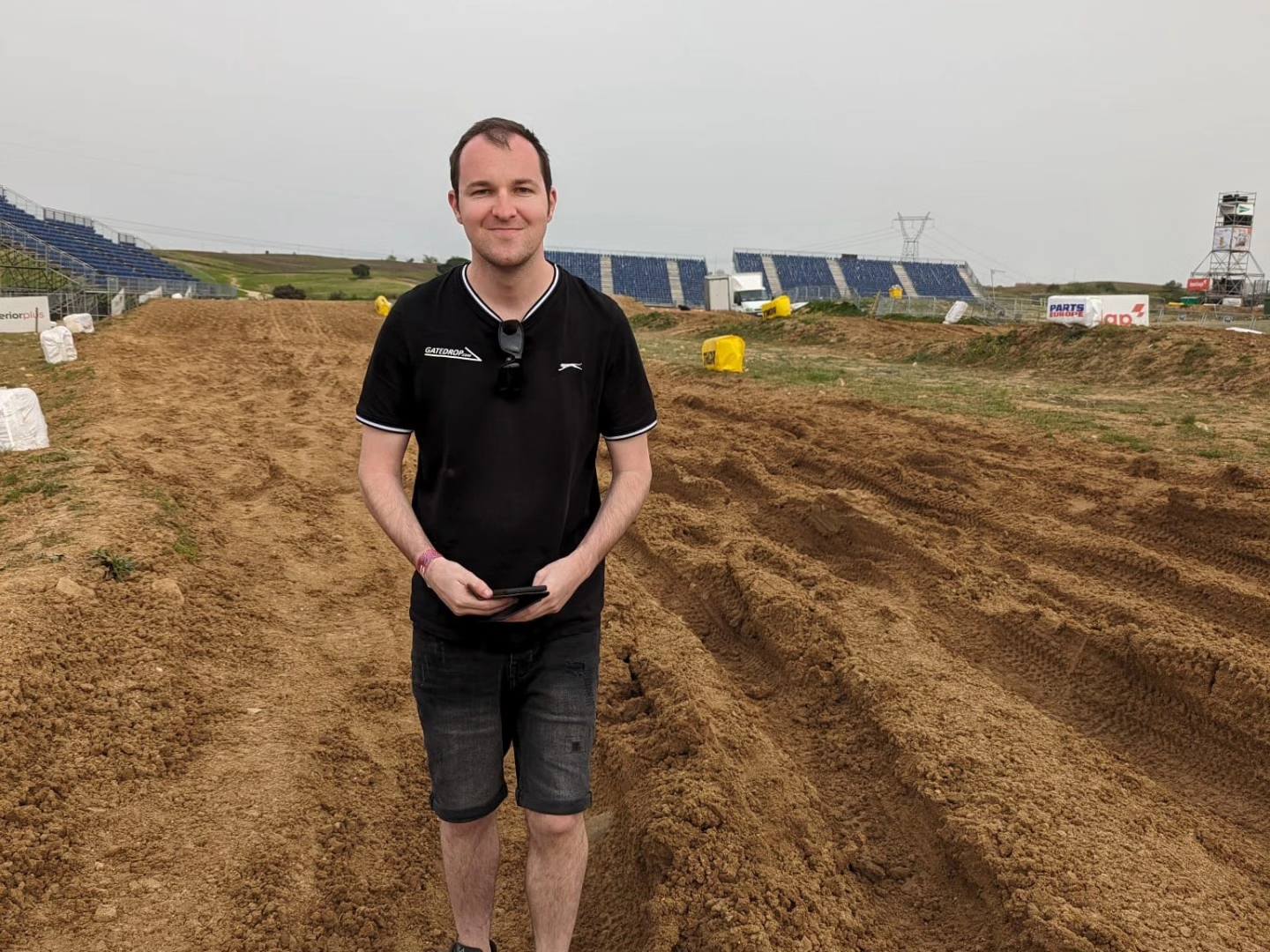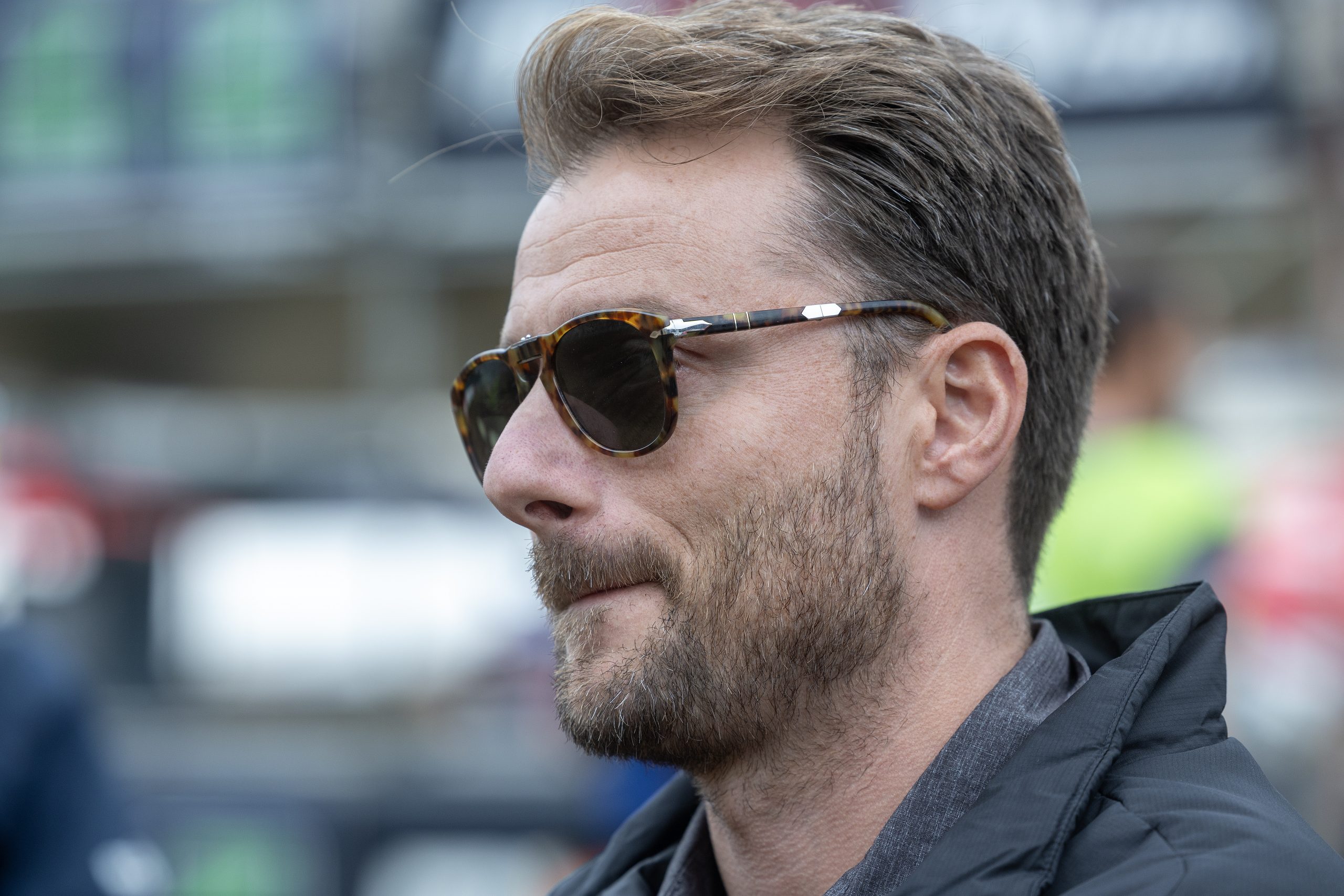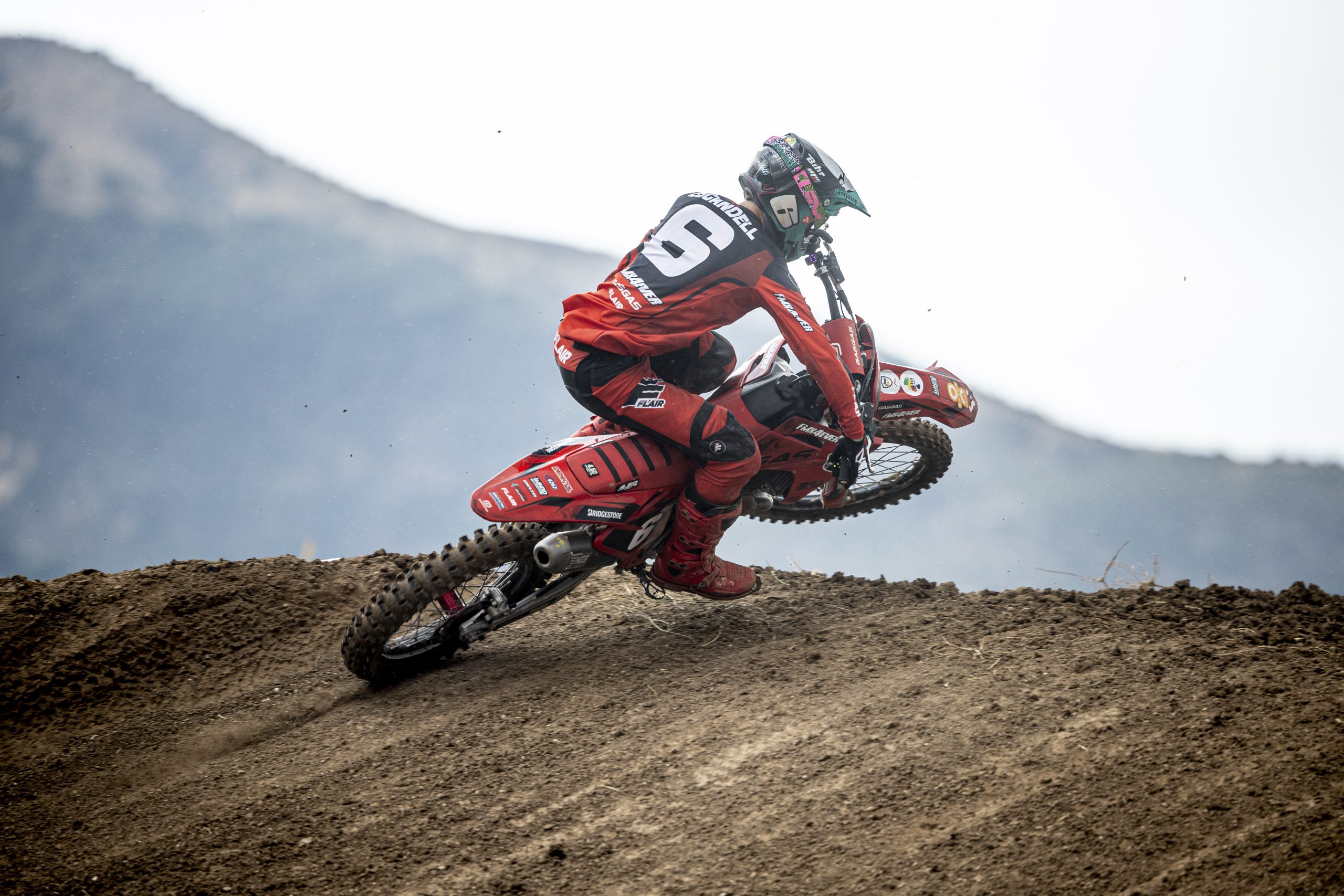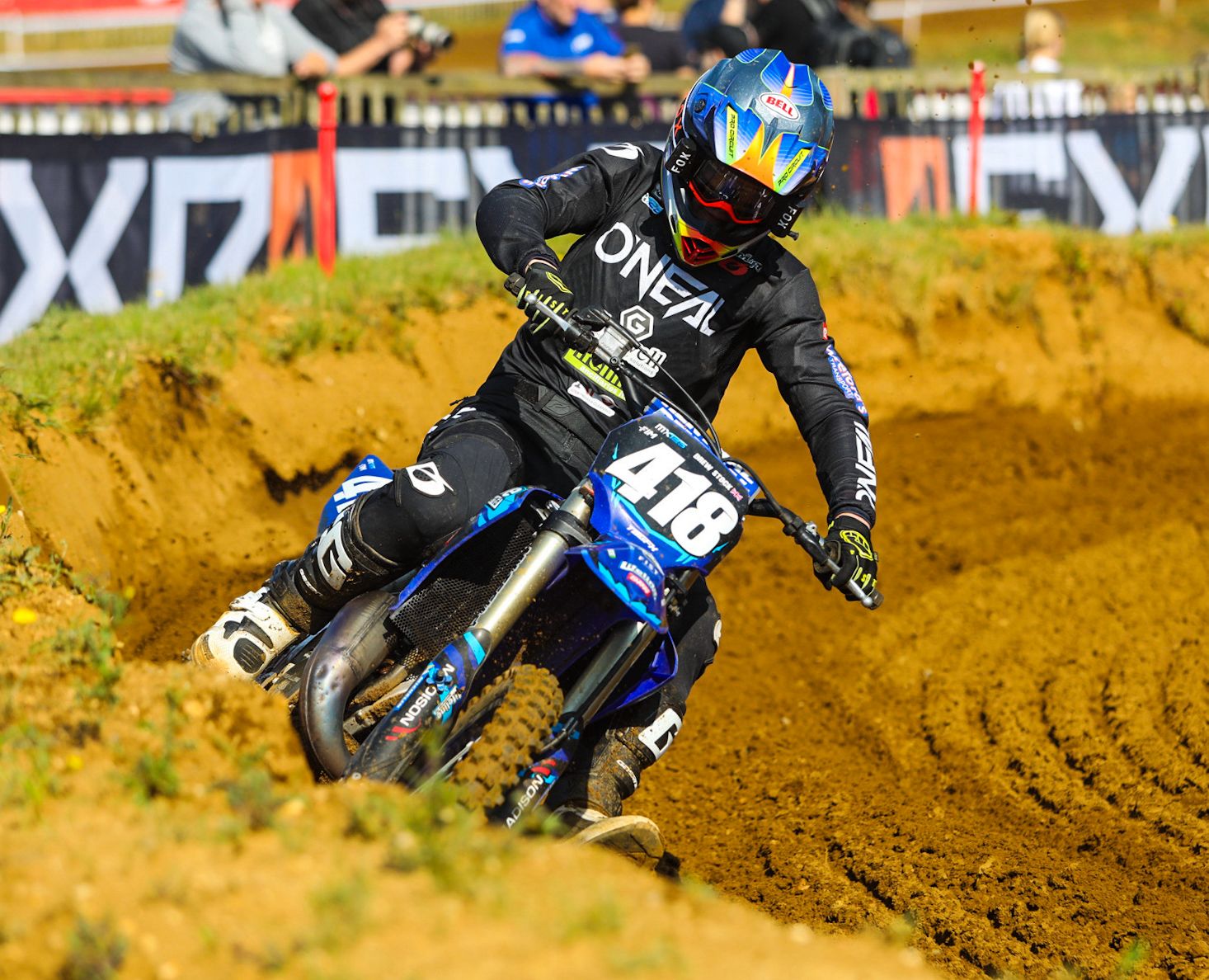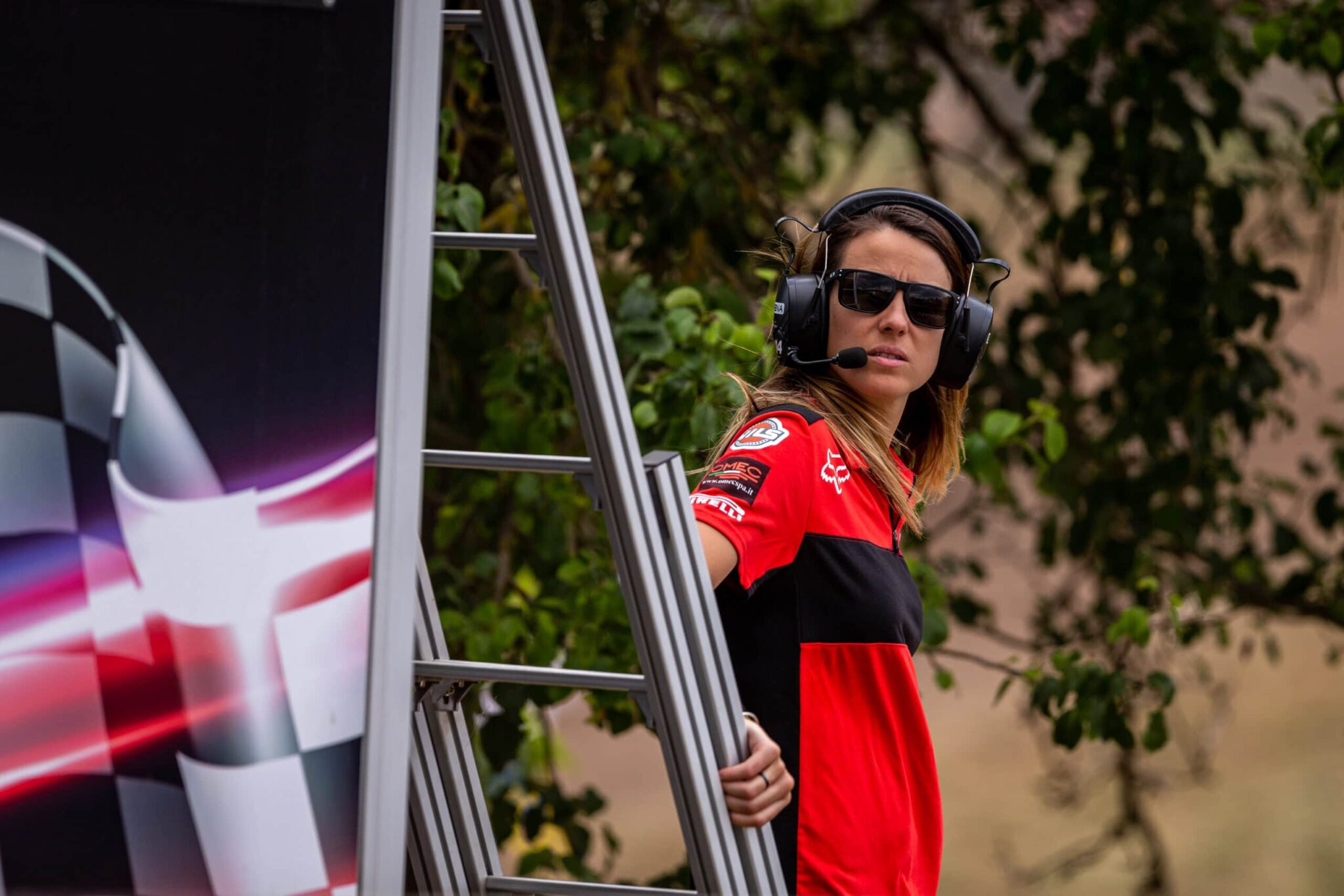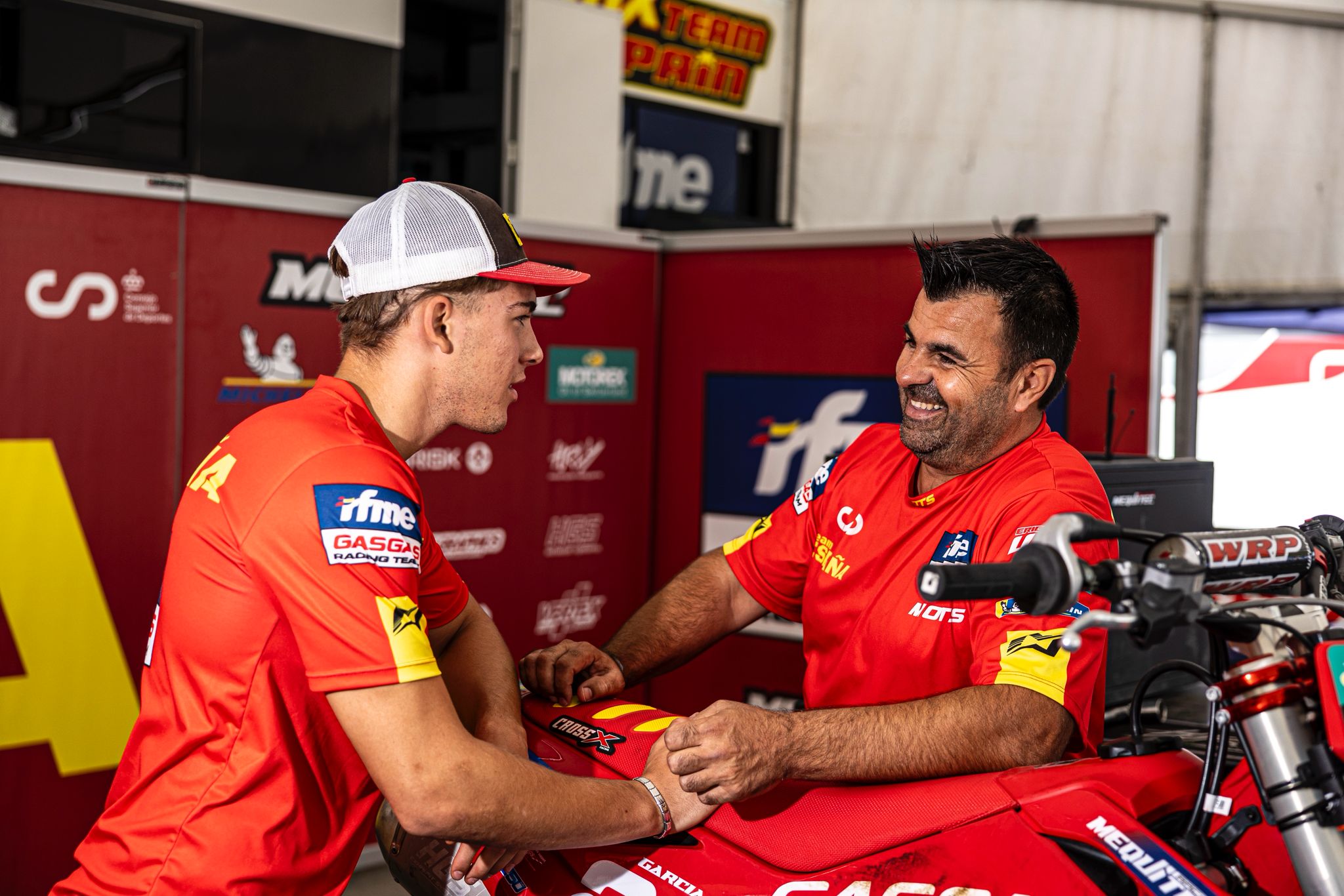With the 2025 MXGP about to end this weekend in Australia, the championship has delivered high drama, unpredictable weather, and world-class battles across all categories. With all three titles — WMX, MX2, and MXGP — still up for grabs heading into the last rounds, the stage is set for a thrilling conclusion.
We caught up with Infront Moto Racing CEO, David Luongo, to discuss his reflections on the season so far, the intensity of the title fights, track preparation, rider development through the European Championships, the growth of WMX, and the challenges of shaping the MXGP calendar. He also shared his thoughts on the future of the sport – from new manufacturers entering the paddock, to long-term projects like MXEP, and the importance of maintaining MXGP’s global reach.
GateDrop: David, the season has flew in as there’s only two rounds left (at the time of the interview), time flies! How would you assess MXGP so far this season?
Luongo: The season is going very well. We made a great journey from Argentina and the bright new track of Cordoba and until the last upcoming events again on new venue in Shanghai and Darwin. It looks like we will manage to have the three World Titles (WMX, MX2 and MXGP) that will still be open until the last round which is also very exciting and a kind of dream scenario for the fans.
We got a lot of exciting Grand Prix during the season. I could mention several like France, Sweden, Belgium, The Netherlands and we got also very challenging weather condition during some races. But this is the beauty of Motocross, we race in very different condition, and we always do our best to deliver great events. The European Championship have been also very good on the sport side with here again titles that have been given during the last round but also in the participation of the riders as we reached new record in term of entries. The pyramid system that we put in place with the Junior is working well, and you can see already the next generation of riders coming into the MX2. Finally, the Monster Energy Motocross of Nations is getting closer and after the announcement of the majority of the teams, we have the certitude that it will be one of the most disputed MXON of the last decades.
GateDrop: The MXGP title has been intriguing all season between the experienced Romain Febvre and the rookie of Lucas Coenen… Have you enjoyed the championship battle and how impressed have you been by the young Belgian rookie?
Luongo: For sure Lucas is impressive for his age and his first season in MXGP class. He is part of the riders that play with the bike, when you watch him riding and not trying to survive or force things, with him, everything looks easy. For sure he is only at the beginning of his career, but he can have a great future in our sport. It is also very rewarding in regard to the European Championships because he and his brother went through the different EMX categories before winning in MX2 and MXGP.
Finally, it is also great for the Belgium fans, who were waiting for years to have again a strong rider competing in the MXGP class, the last Belgium victory was still at the time of Clement Desalle and we know how Motocross is important in Belgium. The atmosphere in Lommel was fantastic. On the other hand, what Romain Febvre is doing is amazing too, he can win a second MXGP World Title, ten years after his first one. For sure this battle has been keeping us on edge for several months, but we cannot forget that Tim Gajser was leading with a big gap before his injury and Herlings is pushing back from his injury too. So the last couple of races have been enjoyable and those four riders are really raising the bar of the level of competition. It will promise an exciting and emotional final rounds!
GateDrop: In MX2, it looks like a two way fight now between Simon Längenfelder and Kay de Wolf, it has been very enjoyable this year, what’s your thoughts been on the MX2 racing? It looks like it’ll go right down to the wire!
Luongo: As you mentioned correctly, Simon Längenfelder and Kay De Wolf are in the best position before the last two Grand Prix, but in our sport, nothing is over until the checkered flag. Even if Andrea Adamo lost important points during the last couple of rounds, the upcoming Grand Prix will take place in warm place and the pressure will rise on the shoulders of the top guys. But what a great season so far, the MX2 category have been very exciting. We had many different winners during the past GP and a great group of new talents who are coming in. We do have 7 different nationalities in the top ten of the Championship ranking, here again a great proof that the pyramid system is working well. Some of them will move up to the MXGP category next year and will bring again some more action into the main category.
GateDrop: Let’s go back to the Swiss GP, everyone saw what happened to Tim Gajser, you could probably say he was pushing very hard but at the end of the day there was a small mound of dirt on the side of the track – not ideal from a riders point of view… What do we learn from this situation and can we expect adjustments or corrections made to the way the tracks are prepared to prevent this from happening again?
Luongo: The case of Switzerland has been debated already in the past months. Along the track there are some dirt obstacles which are made to prevent riders going out of the limit of the track, to hurt marshals, medicals, officials or team managers etc in full speed. In regard to this place, it was a high speed corner where the most used line was inside, on a 7+ meters wide track. On top, you could see a marshal’s position less than 10 meters after the dirt wall.
Tim was pushing as you said, and he went to the grass area on the edge of the track, his back wheel went side line and then it hit the dirt wall. The safety on the track for all the stakeholders and people present onsite is always our top priority as the FIM’s top priority. We put in place some years ago, the rider’s ambassador program where two riders are representing the MX2 and MXGP class every singly weekend. They exchange with us from Friday and during the whole Grand Prix. This system is working very well.
GateDrop: On track prep, there’s a lot of ripping hard pack tracks these days to create ruts everywhere but then it makes it hard to pass because it’s not as open and riders can’t move in a rut. Will this be the way track prep will continue to be? Have you ever thought about ripping parts of the track and then leaving other areas to try and keep both sides happy?
Luongo: The tracks of the Grand Prix are prepared according to the soil and to the weather forecast which we deal with during the week before the event. This year, I have heard sometimes in the press people saying that the tracks were too much ripped in places where we, in fact, didn’t rip them at all! The reality is that we want to make the GP tracks the most technical and demanding possible as we are the World Championship, and not highway. When we get dry conditions, not ripping the track would lead to dusty races with the full program of the weekend, especially on Saturday, which would be more dangerous for the riders’ visibility and make the speed on the track too fast.
The factory bikes technology is pushing to the limit in some cases especially on the suspension side. You can see some old school tracks struggling with the speed becoming a problem and excepted some modifications on the layout, ripping and watering are also helping the organizers to reduce the speed. On the passing, I still believe that the top riders will always find a way, and we can see this every weekend. If some of the top 5 guys are missing their start and would be 25/30 position after the first corner they will find a way to comeback top 5, then once they arrive top 5, it is more difficult to pass because the level is very high. Once you see the Time Practice session, we have had more than one-time 6/7 riders in less than a second. When you are racing at this level you need to take the extra risk or to see something that the other riders would not see to pass them. And the best riders always find a way. The track is always better for the winner than for the second position rider.
GateDrop: There seems to be a bit of an issue when it comes to the amount of riders in EMX250 and MX2. There always seems to be more in EMX250 even though it’s just the European championship. Have you got a plan in place to get more riders in MX2 instead? I don’t really understand why the wildcards do EMX250 instead of MX2 a lot of the time… Also more riders in MXGP at times would be nice too!
Luongo: The pyramid system we put in place is also playing a game in the number of entries. I believe it is also important to talk about reality and not impression. For sure when we go overseas, far South Europe or far East Europe, the number of riders is decreasing, it has always been the case. This year, the number of riders in MX2 decreased a bit compared to last year, but some riders went into MXGP class and the next generation of riders of the MX2 category will come from EMX250 next year.
About the general number of riders participation, I have to say that it increased during the past 3 years. I want to remind that during the Covid time, we put in place a championship for all the categories, which allowed the riders, the teams, the mechanics, the media, to continue to have activities and to keep their work. Thanks to this, we were able to restart after Covid with a strong lineup that continued to increase. For example, from 2022 to 2024 we went from 538 riders participating into the MXGP category to 613 in 2024 (I talk about the total amount of riders that participated to the races), in MX2 from 482 to 585, in EMX250 from 455 riders to 457, and in EMX125 from 560 to an impressive 663. Those numbers are official and are not linked with emotion.
Here again, our main target is to create a system where the best talents and most promising riders will have professional structure to reach the MXGP category as the pinnacle of the sport. In EMX125, we have most of the time two groups of riders and those kids will be the talent of tomorrow. Then when you arrive in MX2 and MXGP, we want to focus on quality riders. When you arrive to the top of the world with the MXGP, you cannot deal with a 40 lineup riders which will be this level. We believe 25/30 would be a great number to reach.
GateDrop: Factory teams these days don’t always sign a fill in rider when there’s an injured rider. Have you ever thought about putting it in contracts to the factory GP teams that if a rider gets a long term injury – they must sign up a fill in rider?
Luongo: This is a point which is already in our agreement, therefore it is quite difficult for a factory team to just “put” a rider on a factory bike which today required a specific preparation and understanding. Some factory teams who have a full line up from lower class find a solution most of the time because they have some testing riders ready or EMX riders that can join the teams. But it would be difficult to just put a C-level riders on a factory bike just to make the number.
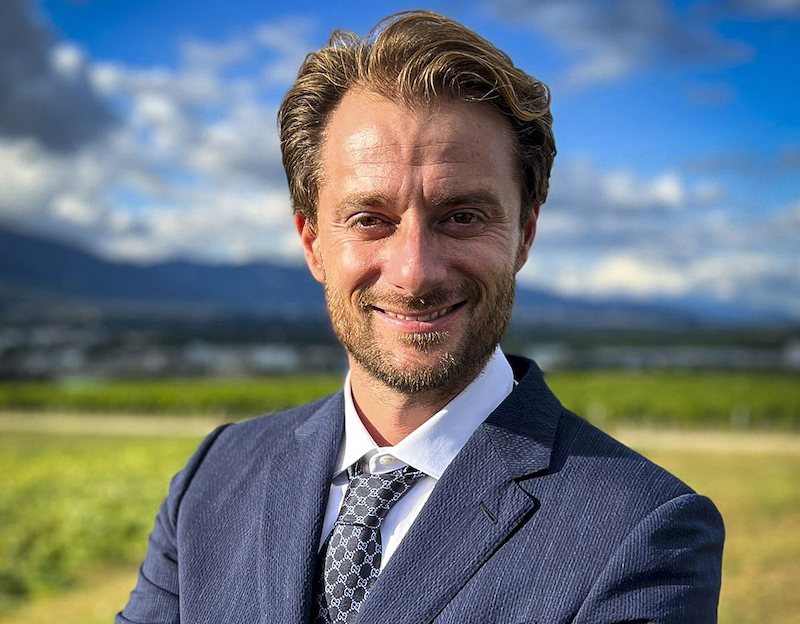
GateDrop: Over the past decade, the EMX125 championship has expanded from 8 to 12 rounds, offering young riders a strong platform to develop their skills. However, considering that most of these riders are between 13 and 17 years old, it raises concerns about how much time they can realistically dedicate to their education. At that age, schooling remains essential for their future, especially since not all of them will make it professionally. What are your thoughts on the balance between racing commitments and academic responsibilities for these young athletes?
Luongo: You see this in all the professional sports. To be able to ride with the best riders in the world you need to start riding on professional track, in professional environment, surrounded by trainers, structures etc… as early as possible. In football, or karting, or basketball, it does start even earlier. The success of the EMX125 series is the key to the talents of tomorrow. We started this system almost two decades ago and now we see families or federations from all around the World choosing the EMX125 because it is the most competitive Junior championship that exists up to now.
Concerning the number of races, this year was special because we had to replace Indonesia double Grand Prix with European races. Therefore it was very important for me to give the chance for the British and Finnish riders to have access to the EMX125 on their soil, as they need to travel a lot to participate to the continental of Western races.
GateDrop: Finland was a late addition to the calendar and making it thirteen rounds of the EMX250 series, I know a lot of team managers weren’t happy about this as budgets etc were already allocated. Bruno Verhaeghe also told us it’s easier/cheaper to get to Indonesia – perhaps Infront could offer teams more support for the teams to get to rounds in places like Finland? We saw the low entries in MXGP and MX2 at the weekend…
Luongo: As I mentioned, the two late races in EMX125 and EMX250 were added after the modification of the calendar. We don’t have to forget that we almost created this championship from zero, once it was literally organized in very random places in the past without any attention from the media, and the riders competing didn’t have any chance of fighting into the MX2 category. Now, it got a lot of success, and some privately owned team managed to get also factory support to make the whole championships with much bigger and costly structures than before. Now they manage riders who will then jump into MX2 category for factory teams. I don’t manage the budget of the teams but two overseas less was also meaning costs saving for the rest of the season. We don’t aim to go for more races in EMX250, but this championship will remain the access class to the MX2 category, so the riders need to have a strong championship, and all this will continue to rise the overall level of MXGP.
GateDrop: Thirteen rounds of EMX250 also means not many chances to wildcard MX2 and actually more rounds than the World Championship used to get. Moving forward perhaps there could be less EMX250 rounds?
Luongo: As I mentioned, we don’t want to increase more the number of races in EMX250, a number in between 11 and 13 is good. But again, we want to have quality and fast riders in MX2, therefore I don’t believe that riders who are outside of top 15 in EMX250 would like to come in MX2 and be much slower than the pack. For what concern the top guys in EMX250, once they battle for the European title, they would rather not risk getting injured for competing in MX2 as a wildcard.
GateDrop: Vertemati are currently working on a Motocross bike to make a return to racing. That is exciting – have you heard about their project and when we might see them enter MXGP in the future?
Luongo: I am very proud about the fact that MXGP is the Motorsport World Championship with the biggest number of official manufacturers participating. This is showing how motocross is still in a dynamic progress despite all the challenges we are dealing with, especially in Europe. It is also a reward about the work we put together with the MXGP stakeholders to make this sport more popular on TV and globally. We count 9 official manufacturers and the freshly coming of major and iconic brands like Triumph and Ducati were fantastic. We didn’t get any official approach from Vertemati until now, but we will welcome them with great pleasure. I am pretty sure we will see other brands coming to the sport in the future, especially with the development of offroad in Asia and China.
GateDrop: The electric class (MXEP) is being introduced to MXGP next year. What’s the latest with the MXEP plans – how many rounds will it get and what manufacturers are likely to contest it? Hopefully some good riders do it so it could be interesting…
Luongo: The MXEP project was put in place after a strong demand coming from some manufacturers and federations back in 2022. At this time, it was a dynamic concerning those new technology. As we didn’t want to mix the classic ICE engine and electric motocross during the same race format, we gave a four-year plan to the manufacturers to check and understand if they would be ready to launch a support race during the GP weekend from 2026.
After several meetings and talking during the last years and considering the state of development of this technology for the different manufacturers we decided to postpone the series to an indeterminate date. You can see that Dorna did a similar action the past days with their MotoE series. We will continue to monitor the situation. For now, we are happy with the KTM e-motocross series which allow young kids to have a first step into our sport during 6 Grand Prix, and we will continue to concentrate on the soul of our sport, the ICE engine.
GateDrop: Is Infront Moto Racing still in discussions with the AMA about organizing a hybrid event in the U.S., and how realistic is it that such a race could take place in the coming years? How have American promoters responded to the idea so far?
Luongo: We mentioned it several times, for the moment we focus on continuing to strengthen our relationship through the Monster Energy Motocross of Nations. We agreed together to go again to USA in 2028 and 2031 for the biggest offroad event of the year. Concerning the joint MXGP/Outdoor event, there is still a long way to go. In my view it would be a race that every fan of motocross would dream, so it is project that is worth to work for, I would never say never, but not for tomorrow.
GateDrop: Are you invested in keeping the WMX series – perhaps they could be given an extra round or two in the future if EMX has a few less rounds here or there?
Luongo: We created the first Women World Championship almost 20 years ago, and despite our efforts to push the series over the years adding some races and even bringing them to Australia, I can say that the answer of the motocross community is not satisfying. For sure the new generation of riders like Lotte van Drunen and Daniela Guillen are bringing new fans to the sport, but they are very much linked to countries from where they come from. We will continue to invest into the series and to manage to make 5/6 events per years during the Grand Prix.
GateDrop: Has Infront Moto Racing implemented any measures to support WMX riders in making the trip to the final round in Australia? It’s a challenging and costly journey, especially for many of these women who, in most cases, don’t earn a living through racing…
Luongo: We implement the same measures as the MXGP and MX2 Championship, with a kgs allowance in regard to the freights. This allows to transport the bike and material without any extra cost for 2 bikes. We are running a World Championship and this race in Australia is great occasion for the girls to compete against Australians and New Zealanders.

GateDrop: Just on Australia, it’s the final round of the series. Whilst it’s important for the series to go outside Europe, do you not feel it would be better to have the final round in Europe? It’s more ideal for the fans and riders because loved ones etc can all go in Europe… Maggiora for the final round a few years ago was magical… Perhaps next year the final round could be in Europe again?
Luongo: F1 is ending its season is Abu Dhabi. For sure, ending the season in Europe could be easier for all of us, but when we build a calendar of 20 Grand Prix, we have to deal with the obligations also related to the local organizers. It has to go from the weather conditions at some time of the year to the other events taking place in the country and also to keep in mind the most efficient and less costly way of making the trip, because the problematic of the team with the freight are multiply by 20 for our material.
Concerning the oversea rounds, they are very important for the growth of the sport. We promote a World Championship, and as all the other sports, the development of motocross must go through growing and dynamic countries. South America, Southeast Asia, Middle East are the places where our sport can gain much more fans and traction. It can be for several reasons, as a huge fan base already existing like Argentina, or one of the major motorcycle market like Indonesia or Australia, or because of the fast growing fan interest on the media side, in Turkey, for example, the GP was on four national television LIVE on Sunday, it will be the case also in China and Australia.
In most of the case the infrastructures of the newly built overseas races are allowing us to host people coming directly from the big cities and give an extra visibility to motocross (Cordoba for Argentina, Shanghai for China!) and will bring a massive crowd to the race. We try as much as possible those Grand Prix at the beginning or at the end of the season. In Europe, we concentrate the main and most popular races from April to August when we have great weather conditions. For this season, the connection between Turkey-China-Australia allowed us to minimize the cost of such travel and the finale will be taking place in Darwin on a brand new track. I am sure it will remain a fantastic celebration as a massive Aussies’ crowd will come to support the GP riders.
GateDrop: What’s the status with a British GP? Correct me if I am wrong but I think this year was the last in Dixon’s contract – is there likely to be a British GP in 2026 and beyond? If not at Matterley Basin, have other options been looked into?
Luongo: Thanks to Steve and his team, their passion for the sport and energy, the British GP was able to take place over the last years. Matterley Basin is clearly one of the most beautiful and most appreciated track in the World. The fact is that it is more and more complicated to get the authorizations and the support from the local authorities for the Grand Prix in UK, for environmental reason mainly. Therefore we are also investigating into other options for the future to keep the British Grand Prix on the calendar. It is clearly our will to keep bringing the GP to the British fans.
GateDrop: How is progress going on the 2026 calendar – when can we expect to see it? Can you also walk us through the challenges involved in putting together an MXGP calendar, and how difficult it is to consistently secure 20 rounds each year — especially considering the frequent changes we see during the season?
Luongo: The calendar is the most difficult things we manage. As I mentioned, we have to deal with the will and the obligations of the different organizers. Sometimes we have to get into consideration the weather conditions too, for example, Indonesian Grand Prix could take place only at the beginning of July for the weather conditions. But in general, we try to put the overseas races at the beginning of the season and at the end because the weather is not as good in Europe. Then to start in Europe with the Southern countries where the weather should be better even if nowadays it is not sure. We keep the main Grand Prix from May to July.
Our objective is to reach the twenty Grand Prix with four to six overseas which really cover the World most famous or growing areas for offroad like South America, South East Asia, Middle East and Australia. Then the fourteen to sixteen great European Grand Prix that would be a mix of old school tracks that can host the infrastructure of the GP and some new tracks that meet better the need of the new fans (KymiRing, TT Assen). We are finalising the calendar in the weeks to come and should be ready to announce the provisional one after Australia. Then during a season, there are always challenges faced by some organizers and we have to deal with some modifications.
GateDrop: For 2026, it’s going to be an interesting season as it sounds like Herlings and Gajser will be moving teams and Vialle might be back to race MXGP. How much are you looking forward to the 2026 season – there will be a lot of unknowns!
Luongo: I believe that it could be the most exciting season since long. We will wait for the future announcements but for sure the MXGP category will be very strong and exciting. And this is what all the fans want to see, great riders battling together. But we still have some great events in front of us in 2025.
GateDrop: We’ve currently got Benoit Paturel and Valentin Gullod racing the AMA Pro Motocross series (Cornelius Tøndel also done three) – if it was their dream to do Supercross and they were doing that over there, fair enough… but they’re racing the outdoors as opposed to the MXGP World Championship. Is this a concern for you?
Luongo: We always witnessed riders going abroad to race the Supercross and then outdoors as a continuity of the season. As you mentioned, it was a dream for them to try before the end of their career, and they did it. On another hand when a younger rider wants to ride supercross in stadium, it happens clearly in the US. For what concerns motocross, the MXGP World Championship is the most demanding series in the World, with twenty different track, soils, preparations, weather conditions.
The riders work with factory bikes which are prototypes. We have the two days format, we got much more time on the bike on very technical tracks. I really believe now that Supercross and Motocross became almost two different sports. I don’t see this as a problem. We will continue to grow fantastic talents through our different European Championships that will be tomorrow’s MXGP stars.
GateDrop: Are you thinking about making any changes for the 2026 season – the format is good but perhaps something could be done to help the number of riders in MX2 and MXGP? I don’t have the answer but perhaps prize money and/or more support for the teams?
Luongo: We won’t make changes in the upcoming season concerning a format that works great. We will continue to improve the details and the presentation. We will implement a celebration after the qualification races for both MX2 and MXGP that will be a bit different than the one of Sunday podium. We will continue to invest in MXGP-TV and in the social media to reach younger audience. We are probably the motorsport with the youngest audience in the World, with 55% of the MXGP fans who are between 16 and 35 years old.
GateDrop: Shouldn’t manufacturers also play a role in supporting riders – much like in the U.S., where contingency programs help non-factory riders continue racing professionally?
Luongo: I really believe that if you take away the injured riders we have every year and that unfortunately we will have in the future, the number of riders is acceptable. We have between 30 to 35 OAT riders at the beginning of the season in MX2 and MXGP. Here again in World Championship, we want the best riders in the World, and the quality is the target. The EMX championships are bringing the quantity of future talented riders who are under the eyes of the factory team to get a future contract. The manufacturers are supporting also some privateers in the paddock, and we never saw a great young rider ending without a contract for racing. Finally as I mentioned, nine official manufacturers have at least two factory riders this season which never been the case in the past.
GateDrop: Currently, the MXGP post-race press conferences are held in person, and the media room is often filled primarily with photographers. A colleague of mine from DailyMX sent in a detailed idea of hosting these conferences online, allowing journalists from around the world to participate and ask questions remotely. Is this something that could be considered in the future? The U.S. series handles this very well, and it could be a great step toward increasing MXGP’s global reach and visibility…
Luongo: It is a question we are investigating now; we prefer to give the priority and access to the media that assist in person to the event. It is also bringing some reality check to the questions they can actually ask because they were present onsite during the event.


